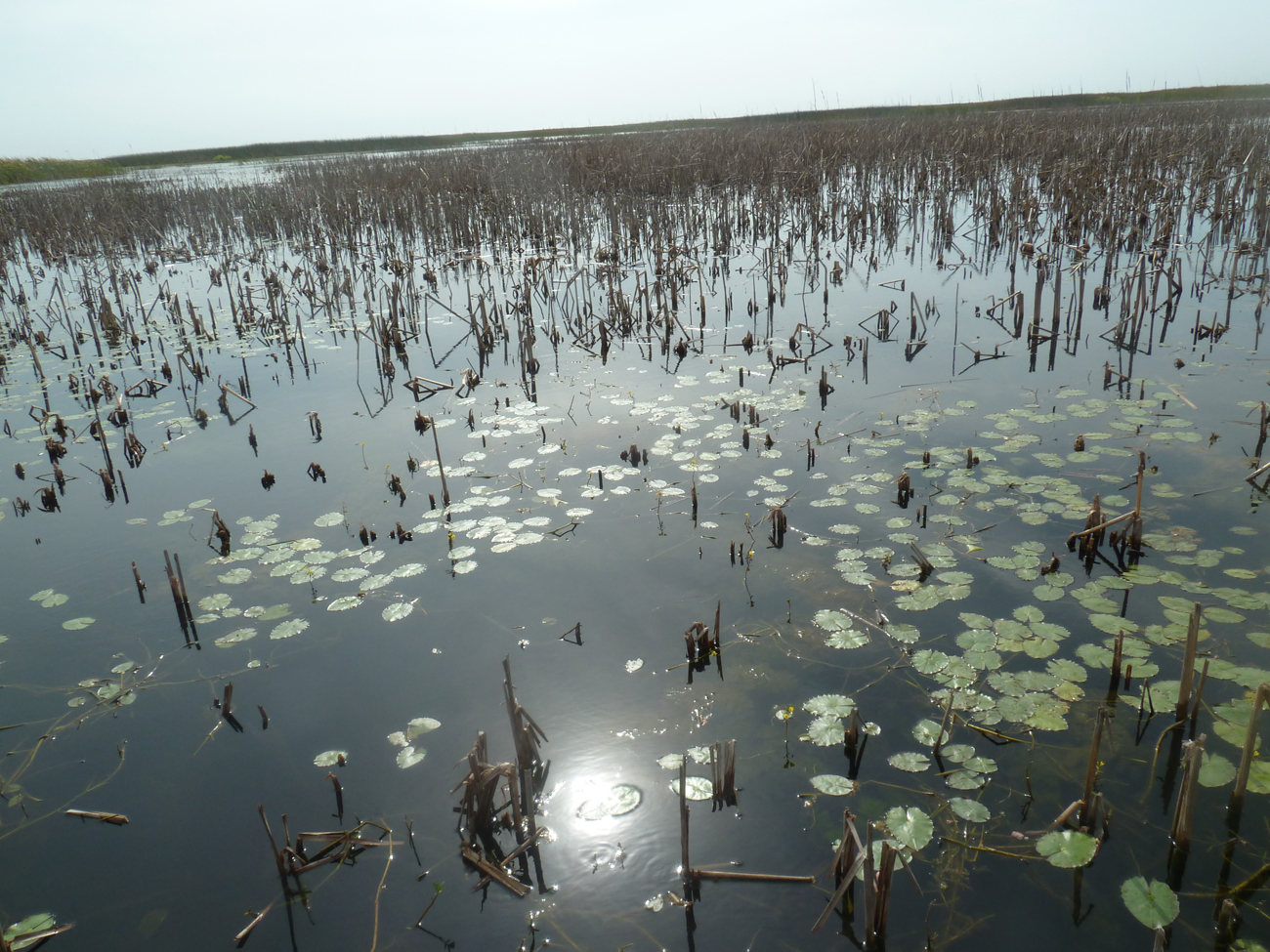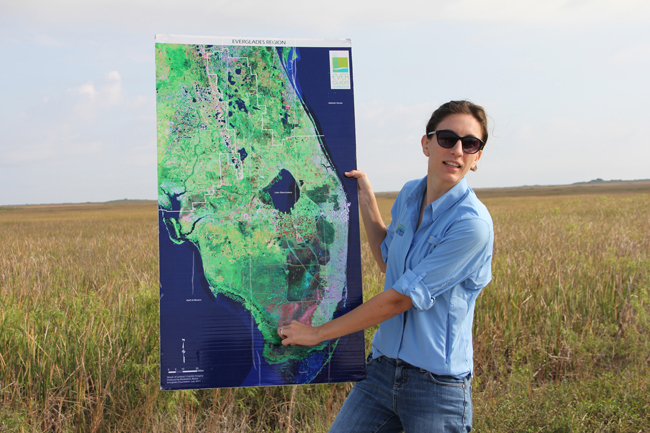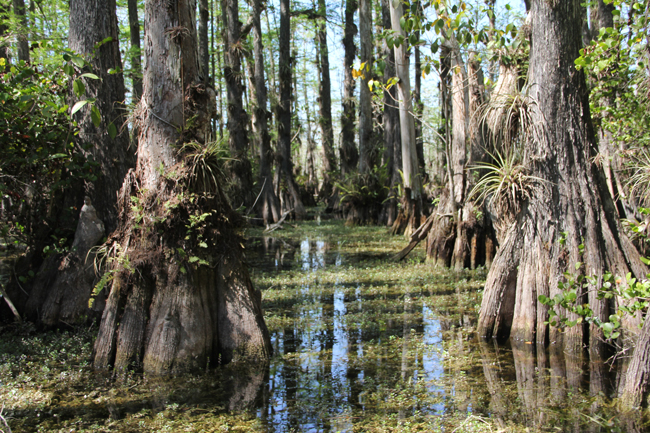After A Century of Destruction, Decades of Restoration, Fight To Save Everglades Struggles Onward
By Caitie Parmelee
Sixty-seven years ago, a tragic death was imminent, and nobody was doing anything to stop it.
The Everglades, Florida author Marjory Stoneman Douglas wrote, were vanishing. Birds were disappearing, the saw grass prairies were burning and the supply of water needed to quench the region’s thirst was rapidly decreasing.
It was time for the government to take action, Douglas said, before there was nothing left.
“The Everglades is a test,” she said. “If we pass, we may get to keep the planet.”
Billions of dollars and nearly seven decades later, we are still struggling to pass this test through what has been described as the biggest ecosystem restoration in the world.

Photo by Zarrin Admed
Over the years, several restoration efforts and projects were initiated, but none addressed the root of the destruction. It was not until the Central Everglades Restoration Project (CERP) was authorized in 2000 that the government would come to understand that it all comes down to water.
“The overall goal is to get water flowing south out of Lake Okeechobee,” said Howard Gonzales, chief of the ecosystem branch at the U.S. Army Corps of Engineers.
Despite the belief that they now know the root of the problem, there is still no easy solution. It all comes down to water, but it is not just about water. It is about money, politics and history.
Hundreds of years ago, this unique and fragile ecosystem was kept intact by the natural water system. During the wet season from May to October, Lake Okeechobee would spill over and the water would flow south into the wetland area as a sheet flow. This flow hydrated an ecosystem that does not exist anywhere else in the world.
It was not to last. The Swamp Lands Act of 1850 authorized the reclamation of the “swamplands” so the land could be developed for society.
Developers started planning for the future. Henry M. Flagler, the partner of oil tycoon John D. Rockefeller, bought hundreds of acres to build railroads that would run throughout Florida. Flagler was a penny-pinching, self-made businessman who had a tendency to reuse stamps to save money. Rockefeller described him as “a man of great force and determination, though perhaps he needed a restraining influence at times when his enthusiasm was roused.”
His enthusiasm was certainly roused by the idea of making his mark on Florida. Flagler would spend millions on an attempt to develop the land – an attempt that would ultimately fail.
As Flagler spent his money buying every bit of land he could grab, people started buying settlements in anticipation of the newest destination for opportunity and American exceptionalism. But even as this happened, no one seemed to be able to actually fulfill the promise of dry land. And then in walked Napoleon Bonaparte Broward.
Broward was a large man, full of charm and confidence, and he was convinced the Everglades could be drained. He made impassioned speeches, pointed to examples of human innovation and fueled people with the conviction of their power over nature. When he took office as governor in 1905, Broward immediately started building canals, selling land and planning for the future of Florida. The land stayed dry for some time, and then a little bit more. When Broward left office in 1909, everyone was convinced he had done it. Broward had drained the Everglades.
Unfortunately, he forgot about the rain.
The 1920s brought new prosperity to Florida, quickly followed by two deadly hurricanes. In 1926, a storm hit Miami, destroying thousands of houses and killing hundreds of people. A hurricane in 1928 killed 1,800 more, and convinced officials that Lake Okeechobee, a huge source of flooding during the storms, needed to be controlled. A dike was quickly constructed around the lake, and the water that normally flowed south out of Okeechobee was diverted toward rivers flowing to the east and west. The sheet flow was effectively cut off, and it was not until the 1940s that people started to realize that the Everglades were dying.

Photo by Maschal Mohiuddin
Over the last 200 years, humans have done their best to develop, drain, channelize and dike these wetlands so that society could comfortably retire in the sun. These efforts severely disrupted the hydrology of the Everglades, actually making the land less able to sustain human life.
“Without the Everglades, developed areas cannot exist,” said Aida Arik, an ecological engineer for the Everglades Foundation, a science based nonprofit organization dedicated to the restoration of the Everglades.
The first attempt to save the Everglades was made in 1947, following the publication of Marjory Stoneman Douglas’ book, “The Everglades: River of Grass”. President Harry Truman established the Everglades National Park, which would serve as a refuge from development. The Central and South Florida, or C&SF, Project was developed to provide flood control and fresh water to South Florida, making it easier for people to live on the land.
Even Douglas thought these two initiatives would be the key to saving the Everglades. What she and everyone else failed to understand was that even though the Everglades National Park would preserve the protected land, it was still cut off from its natural water supply.
Even more destructive was the C&SF Project. The U.S. Army Corps of Engineers focused on creating better living conditions for society, but failed to take into account the need to have an adequate water supply for both people and the environment, and to make sure the water was clean. It was not enough to only provide flood control.
An example of this dilemma is the channelization of the Kissimmee River, which twisted and meandered for 103 miles through Central Florida. The river was cut and dredged in the 1960s to form straight canals that would protect people from flooding during the wet season. As a result, the areas of land that were meant to be flooded no longer had a water supply. The consequences for the ecosystem were devastating; the number of wading birds in the area was drastically reduced, as well as native fish and animals that could only survive in wetlands.
C&SF was not, however, the only Everglades initiative before CERP. In 1976, Congress passed the Kissimmee River Restoration Act, which led to the authorization of the Kissimmee River Restoration Project in 1992. This project was designed to restore the river’s original flow while accounting for flood control.
Finally, in 2000, the federal government authorized CERP, a collaborative effort to restore the natural flow of the Everglades. CERP had a price tag of $8 billion and a goal to achieve restoration in 30 years.
The two key agencies leading the project are the U.S. Army Corps of Engineers and the South Florida Water Management District, a government agency that oversees water resources in Southern Florida. A range of other governmental and private organizations also participates, including local and federal government and several environmental groups. As this is a science-based project, organizations such as the Everglades Foundation are critically important in the effort to identify problem areas and come up with possible solutions.
They are now 14 years and almost $2 billion into the restoration, and they have come to understand the importance of the water, as well as the collaboration and funding needed to get it right.
Currently, the water flowing out of Lake Okeechobee is being redirected east and west into the Caloosahatchee and St. Lucie Rivers. This is not only wasteful, but it results in sending fresh water into saltwater ecosystems. Because of the lack of water flowing south, this also increases the risk of saltwater invading fresh water environments in Southern Florida.

Photo by Kaitlyn Carroll
By restoring the historical flow of water, more water will be utilized than wasted and there is less of a chance that the fresh and saltwater will mix.
“Moving water south solves a lot of problems,” said Arik.
One way of doing this is elevating the Tamiami Trail. The trail, constructed in 1928, stretches from State Road 60 in Tampa to U.S. Route 1 in Miami. Since its construction, it has acted as a dam for water that is supposed to be flowing out of Lake Okeechobee and into the Everglades. The goal is to bridge the trail, allowing the water to continue flowing south.
According to Arik, the Tamiami Trail is critical to restoration, as it will “uncork the system.” As of March 2013, one mile of the bridge has been completed, and Arik said Governor Rick Scott has allocated $90 million over the next three years for the next 2.6 miles of bridging.
Unfortunately, the issue of restoration is not as simple as restoring the flow of water. According to Gonzales, getting the water right is not just about distribution, but about quality, quantity and timing as well. These are difficult to manage and very expensive.
Water quality is not just about clean water for people; it’s about suitable water for the ecosystem. The Everglades is a low-nutrient system, meaning it needs water containing low amounts of phosphorus to survive. Before development, the water only contained about 10 parts per billion of phosphorus. Because of the disruption to the system and the agricultural pollution from nearby sugar farms, the water going into Lake Okeechobee is roughly between 250 to 600 parts per billion.
Not only is the water polluted, the water levels are hard to regulate. Lake Okeechobee is important for water supply and flood control. To make sure there is enough water for everyone, the lake levels need to be as high as possible. To protect people from hurricanes and floods, the levels need to be as low as possible.
“We’re trying to get all the independent pieces to work as a system again, but they weren’t designed to work together,” said Paul Gray, Okeechobee science coordinator for Audubon Florida.
According to Gray, there are a lot of people who say the water levels of the lake should just be raised to help the rest of the Everglades, but this would destroy the ecology of the lake.
“PR is a problem because a lot of people think Lake Okeechobee is just a mud hole,” said Gray. “But we’re not trying to move the harm from one place to another.”
Don Fox, biological administrator for the Florida Fish and Wildlife Conservation Commission, says the key to success is collaboration. He said people like to place blame on others, but it is everyone’s problem.

Photo by Maschal Mohiuddin
“It’s all a big dance,” Fox said. “We’re trying to get everyone in the same ballroom.”
Several participants believe that their agencies are working well together. Gonzales says they are more aligned now than ever.
“Eight to ten groups meet on a quarterly basis, talk through projects and see where they can help each other,” Gonzales said.
Arik agrees. “[The Everglades Foundation] has to push to be included sometimes, but we have a lot of weight when it comes to influencing policy, and so when agencies plan out these projects, they really want to have us on board. Science drives our policy and advocacy decisions. So a lot of times agencies do depend on our expertise to contribute to the planning process.”
Significant progress has been made. The Kissimmee River Restoration Project is expected to be completed by 2019. Along with this and the ongoing elevation of the Tamiami Trail, the ecology of Lake Okeechobee is slowly being restored and the U.S. Army Corps of Engineers has come up with a plan to tackle the heart of the Everglades. The issue now is money.
“Looking at where we stand now, a lot of our progress depends on appropriations,” Gonzales said. He says it is key that Congress authorizes a Water Development Resources Act, a bill that authorizes and funds all U.S. Army Corps projects. Congress has not authorized this bill, which is supposed to be passed every two years, since 2007.
Whether they get authorization from Congress this year remains to be seen, as this is an election year and it is already May. Gonzales is confident, however, that they will get the help they need. “We are getting signs from Washington with regards to authorization,” he said. “The expectation is that something is going to happen this year.”
This authorization will allow them to start implementing projects that have been planned by the state, but cannot be executed without being approved by Congress. According to Gonzales, the state has expended $400 million to $500 million that cannot be brought into the equation without federal approval.
Federal funding is not the only money issue, however. The restoration has faced state budget slashes the last few years, as conservative Governor Scott cut back on funding for the environmental initiative in 2011, his first year in office.
While Scott has since reversed his position and just this year allocated more of the state budget for the Everglades, the financial slashes were a setback for the restoration effort. One of the projects that has been struggling is the effort to clean polluted water using storm water treatment areas.
Storm water treatment areas, or STAs, are water supply “wellfields” that stretch from Orlando to Key West. These wellfields take water coming from the watershed and filter as much of the nutrients as possible just before letting it continue into Lake Okeechobee and the Everglades. One way they do this is by planting vegetation that thrives in nutrient rich environments, allowing the plants to soak up the phosphorus and send better quality water into the Everglades.
Gary Ritter, intergovernmental representative for the South Florida Water Management District, says the process of reducing phosphorus through storm water treatment areas is vital to restoring the hydrology and it is expensive.
According to Ritter, the Water Management District has suffered from the budget cuts, forcing layoffs and slowing down the process of buying land to create more STAs. Ritter says Governor Scott has recently committed at least $40 million a year to this project for the next four years, but it is not enough for everything they need to do.
Ritter is pleased, however, with the money that is coming from the governor, as are other players in the restoration. Gonzales even thinks that Scott has had a positive effect on the Everglades restoration during his time in office.
“We need to finish projects we have already started,” said Gonzales. “I really feel [Scott’s] been a champion for this, which will then lead further down the line to continued support.”
Though Gonzales expects the restoration to take at least another 30 years, he along with the others feels optimistic about the progress being made.
“We can never get the Everglades to go back to the way it was,” Gray said, “but the goal is to restore as best as possible.”
Ritter agrees. “We can only do as much as possible to achieve restoration as best as we can.”
While the timeline seems daunting, it is important to remember that the restoration of the Everglades is an incredible effort. There is decades of damage to undo, and no room for mistakes. Everything from the birds to the phosphorus to the safety of the population needs to be taken into account.
But if successful, the end result of the time and money spent on this project will be priceless.
There is no easy way to describe the feeling of being in the Everglades. The excitement of speeding along Lake Okeechobee in an airboat, or the sound of the birds on a calm morning at Flamingo Bay. The absolute quiet when walking into a cypress dome completely cut off from the sounds and the stress of the rest of the world. It is simply an immersion in a world of beauty, heat and awe outside of everything anyone has ever known that no words can ever truly describe. It is an experience – and there is no other place equal to it. There will only ever be one Everglades, and we will never get another chance to save them.

Photo by Kaitlyn Carroll
“We’re not going to fail,” Arik said.